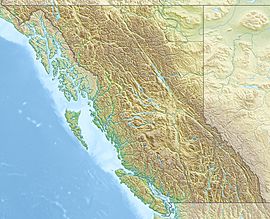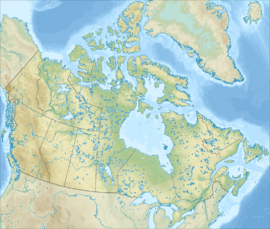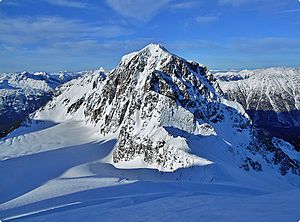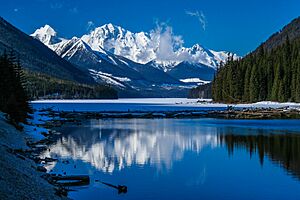Joffre Peak facts for kids
Quick facts for kids Joffre Peak |
|
|---|---|

Joffre Peak, northeast aspect
|
|
| Highest point | |
| Elevation | 2,721 m (8,927 ft) |
| Prominence | 331 m (1,086 ft) |
| Parent peak | Mount Matier (2783 m) |
| Geography | |
| Location | Joffre Lakes Provincial Park British Columbia, Canada |
| Parent range | Joffre Group Lillooet Ranges Coast Ranges |
| Topo map | NTS 92J/8 |
| Climbing | |
| First ascent | 1957 R. Chambers, P. Sherman |
| Easiest route | Scrambling, glacier travel |
Joffre Peak is a mountain in British Columbia, Canada. It stands 2,721-metre (8,927-foot) tall. You can find it in Joffre Lakes Provincial Park, which is in the southwestern part of British Columbia.
This peak is the second-highest point in the Joffre Group. This group is part of the larger Lillooet Ranges. Joffre Peak is about 26 km (16 mi) east of Pemberton. It's also 11 km (7 mi) northeast of Lillooet Lake.
The mountain has two glaciers: the Matier Glacier on its southwest side and the Anniversary Glacier on its southeast side. Water from the peak flows into Joffre Creek and Cayoosh Creek.
The first time someone climbed Joffre Peak was on July 19, 1957. Two climbers named Dick Chambers and Paddy Sherman from the British Columbia Mountaineering Club made this first ascent. They named the peak because it's at the very start of Joffre Creek.
The mountain is named after Joseph Jacques Césaire Joffre. He was a French general who led the French armies during World War I. The name was officially recognized on June 22, 1967. It's important not to confuse Joffre Peak with Mount Joffre in the Canadian Rockies, which is also named after the same person.
Mountain Weather
Joffre Peak is in a subarctic climate zone. This means it has long, cold winters and short, cool summers. Most of the weather in this area comes from the Pacific Ocean.
When weather fronts from the Pacific Ocean move east, they hit the Coast Mountains. The mountains force the air to rise. As the air goes higher, it cools down and drops its moisture. This causes a lot of rain or snow, especially in winter.
Winter temperatures on Joffre Peak can drop below −20 °C. With the wind, it can feel even colder, sometimes below −30 °C. The best time to climb Joffre Peak is usually from July to September. This is when the weather is most favorable.
Climbing Paths
There are several known paths to climb Joffre Peak:
- Southeast Face - This route was first climbed in 1957.
- Southwest Gully - This path was first climbed in 1971.
- East Ridge - This route was first climbed in 1980.





